Logistics in Poland
February 6, 2020
-- Part 2: Rail Transport and the EU gateway for China Land Bridge --
Since 2015, the Nippon Express Group offers several multimodal freight transport services called "Eurasia Train Direct", between China and Europe and from Japan to Europe. Most of these services from Japan/China to Europe go through Moscow (Russia), Brest (Belarus) and Małaszewicze (Poland), etc. before reaching the final destination in the EU. Poland, being "the European border," plays an important role as the gateway from non-EU countries, such as China, Russia, Ukraine, Belarus, etc. to the EU territory, especially in rail transport. (Please see video for more information on Nippon Express "Eurasian Train Direct" https://www.nipponexpress.com/press/video/eurasia-train-direct.html)
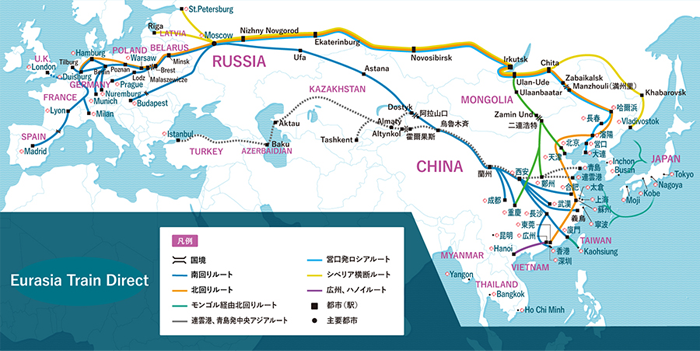
Source: Nippon Express(https://www.nittsu.co.jp/railfreight/)
Rail transport in Poland1
Poland's total track length was 37,195 kilometers in 2017, of which 24,899 kilometers were electrified and 12,296 kilometers were non-electrified (such as diesel), with an electrification rate of 66.9%.
The rail freight volume was around 200 million tons until 2016, but has increased for the third consecutive years since then, and the volume was 242.04 million tons in 2018. The breakdown is as follows: national transportation accounts for 74.3%, international transportation 24.0% and transit 1.7%. Hence, national transportation accounts for the majority of the rail freight transport in Poland.
1.Eurostat database
https://ec.europa.eu/eurostat/data/database
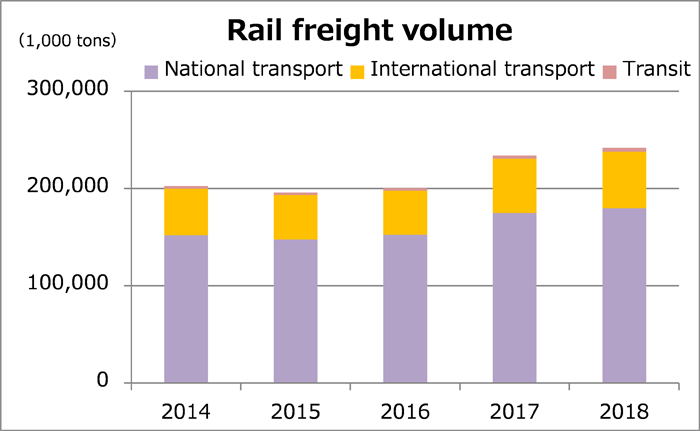
Source: Eurostat (data: rail_go_typepas)
By item, in 2018, "Coal and lignite; crude petroleum and natural gas", was the largest with 96.93 million tons, accounting for 40.0% of the total, followed by "Metal ores and other mining and quarrying products; peat; uranium and thorium" (66.42 million tons, 27.4%) and "Coke and refined petroleum products" (27.75 million tons, 11.5%). It can be seen that bulk freight accounts for a large proportion of rail freight transport in Poland.
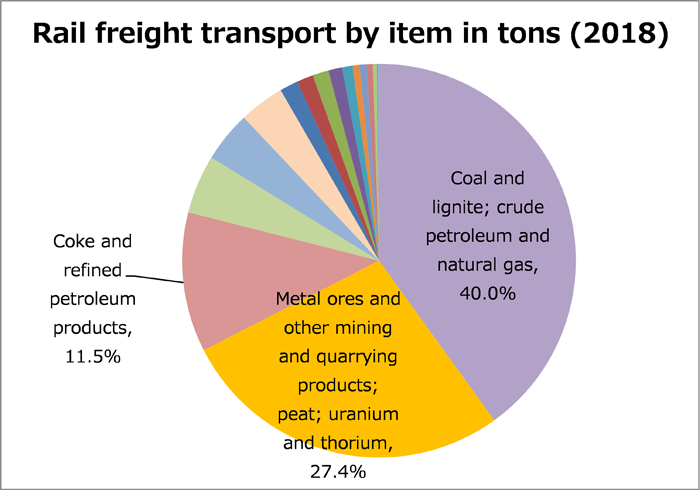
Source: Eurostat (data: rail_go_grpgood)
Polish railway container traffic exceeded 1 million TEUs in 2012 and has increased for five consecutive years since 2014. High growth was achieved in 2016 and 2017 in the 20% range. In 2018, it was 1.7 million TEU, up by 5.9% from the previous year. The breakdown is as follows: national transportation accounting for 50.8%, international transportation 29.5% and transit 19.7%. Hence, national transportation accounts for more than half of the railway containers transported in Poland.
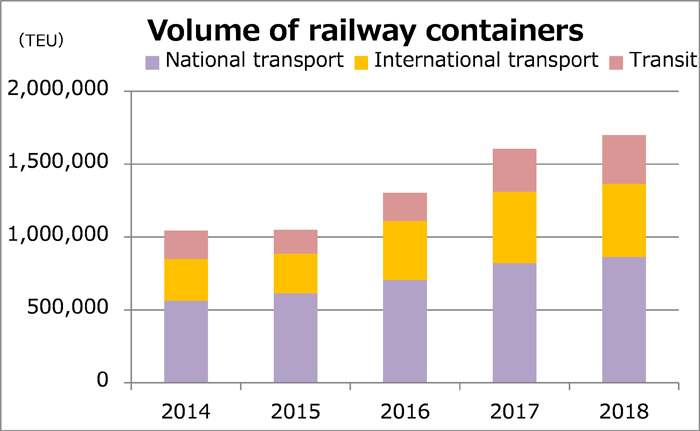
Source: Eurostat (data: rail_go_contnbr)
Rail transport between China and Europe
After the opening of Yuxinou Railway in 2011, railway transport route connecting the European countries from multiple cities in China are formed. When cargos are transported from China to Western Europe by rail, most routes will pass through Moscow (Russia), Brest (Belarus) and Małaszewicze (Poland), therefore Poland plays an important role as the EU's "European border" for rail transport from China to Europe. The gauge (railway track width) in China and the EU is 1,435 mm (standard gauge), whilst that in CIS countries including Russia and Belarus is 1,520 mm (wide gauge). This is why it is necessary to transship containers to locomotives and wagons that match each gauge width. The major tranship point of containers between standard and wide gauge is the Brest, Belarus - Małaszewicze, Poland Border.
Wide gauge (Left) and standard gauge (Right) at PKP Cargo terminal, Małaszewicze
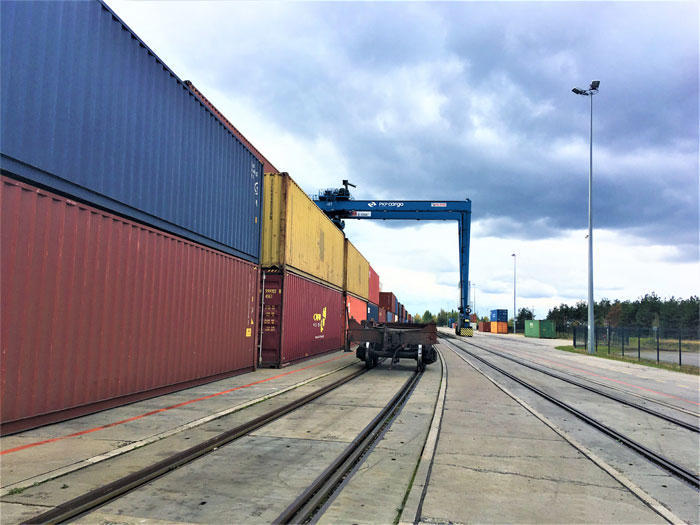
Source: Nittsu Research Institute and Consulting, lnc.
Rail Mounted Gantry (RMG) Crane and Reach Stacker at Europort terminal, Małaszewicze
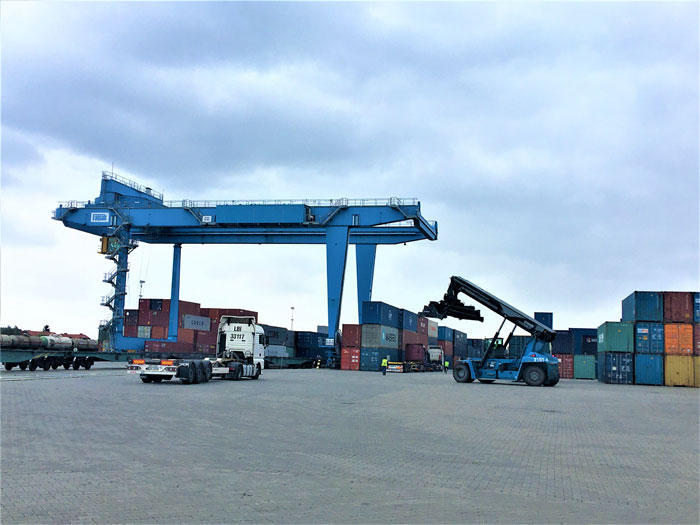
Source: Nittsu Research Institute and Consulting, lnc.
In addition to the gauge difference, there is another difference in railway bills. In the EU and other countries participating in the Convention concerning International Carriage by Rail (COTIF), CIM consignment notes based on a uniform rule called Uniform Rules concerning the Contract for International Carriage of Goods by Rail (CIM) is used as railway bills. On the other hand, in the CIS countries and China, consignment notes based on the Agreement on International Goods Transport by Rail (SMGS) are used as railway bills. As in the case of transhipment of cargo between different gauges, it is necessary to change the waybills when transporting cargo across these areas, by China Land Bridge or the Siberian railways before entering the EU territory. These procedures are usually carried out in the Brest, Belarus - Małaszewicze, Poland Border as well. These are the reasons why Małaszewicze plays a key part in the rail transportation between the EU and China, Japan or other non-EU countries; (1) switching the rail gauges and (2) changing of railway bills.
Rail transport is cheaper than air and faster than sea route
In recent years, integrated multimodal transport services using railways from China, Japan, and other East Asian countries to Europe has drawn attention as it is relatively cheaper than air transportation and shorter in lead time than all-water routes. For instance, as for Nippon Express's "Eurasia Train Direct (China-Europe cross-border rail transport)" consolidated transport service from Shanghai, China to Dusseldorf, Germany, the lead time is about 11-16 days (from Nippon Express CFS in Shanghai to Nippon Express CFS in Dusseldorf)2 . Compared to the lead time required for all-water route, which is approximately 40 days, the lead time can be significantly reduced. Another service is "NEX Ocean-Solution China Land Bridge", which was launched on September 1, 20193 . This service starts with ocean transport from major ports in Japan (Tokyo, Yokohama, Nagoya, Osaka, Kobe, Moji) to Xiamen, China, and then uses rail transport from Xiamen to Małaszewicze, Poland, and to Hamburg and Duisburg in Germany. The lead time from a major port in Japan to a railway terminal in Europe is approximately 23-25 days, which is significantly shorter than all-water routes, which usually take about 40 days.
2.China-Europe cross-border rail transport (Eurasia Train Direct)
https://www.nipponexpress.com/service/transportation/cross-border/eurasia-train-direct/index.html
3.Nippon Express: Nippon Express begins Sea & Rail multimodal service from Japan to Europe via Xiamen (September 6, 2019)
https://www.nipponexpress-holdings.com/en/press/2019/6-Sep-19-1.html
Reference:
- Nippon Express: China-Europe cross-border Rail Transport Service-From Xi'an, China to Duisburg, Germany
https://www.nipponexpress.com/press/video/eurasia-train-direct.html - China-Europe cross-border rail transport (Eurasia Train Direct)
https://www.nipponexpress.com/service/transportation/cross-border/eurasia-train-direct/index.html - Nippon Express: Nippon Express begins scheduled cross-border rail transport service between China and Europe (June 4, 2019)
https://www.nipponexpress-holdings.com/en/press/2019/04-Jun-19-1.html - Nippon Express: Nippon Express begins Sea & Rail multimodal service from Japan to Europe via Xiamen (September 6, 2019)
https://www.nipponexpress-holdings.com/en/press/2019/6-Sep-19-1.html - Eurostat database
https://ec.europa.eu/eurostat/data/database